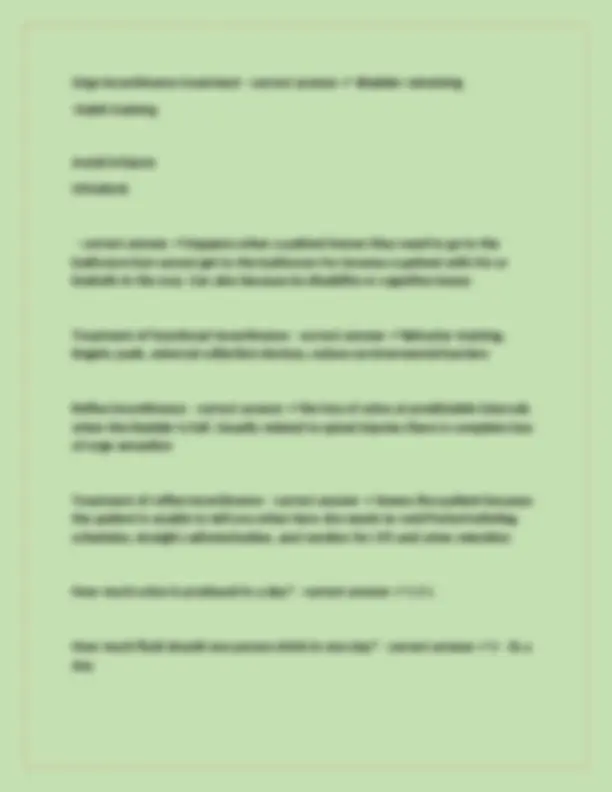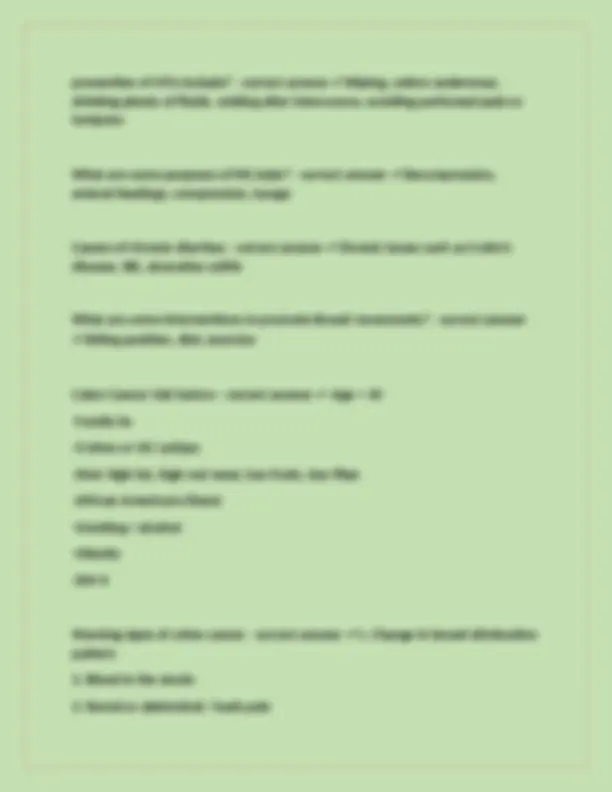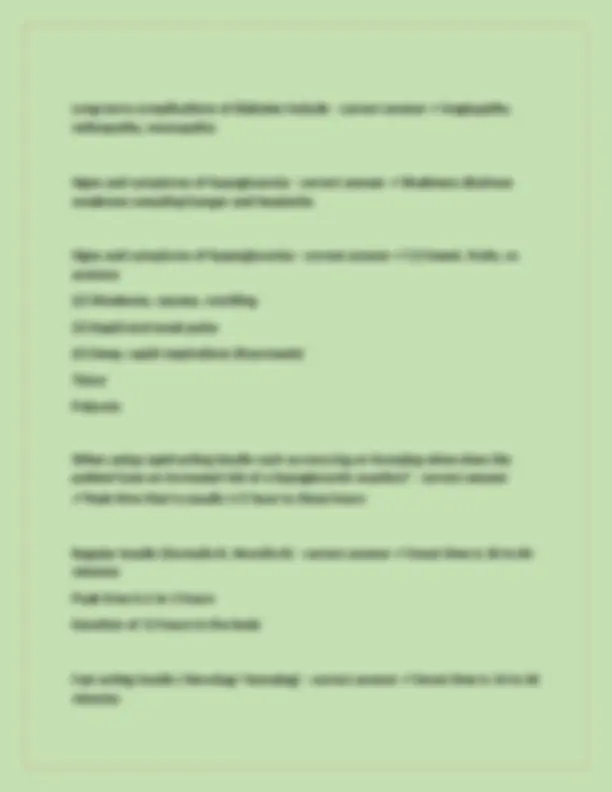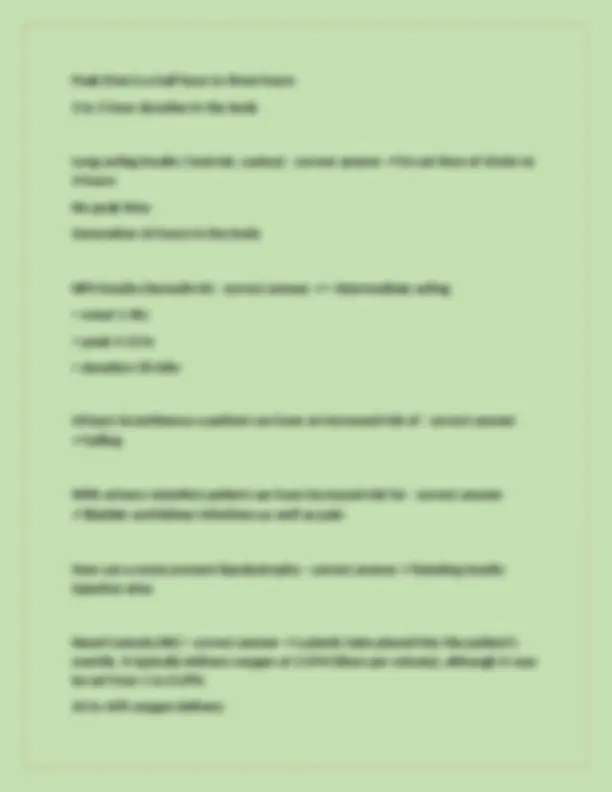











Study with the several resources on Docsity

Earn points by helping other students or get them with a premium plan


Prepare for your exams
Study with the several resources on Docsity

Earn points to download
Earn points by helping other students or get them with a premium plan
Community
Ask the community for help and clear up your study doubts
Discover the best universities in your country according to Docsity users
Free resources
Download our free guides on studying techniques, anxiety management strategies, and thesis advice from Docsity tutors
A comprehensive overview of key concepts related to urinary and bowel elimination, fluid and electrolyte balance, diabetes, oxygen therapy, and medication administration. It includes definitions, causes, treatments, and nursing interventions for various conditions, making it a valuable resource for students in the healthcare field. The document also includes multiple-choice questions with answers, providing a self-assessment tool for students to test their understanding of the material.
Typology: Exams
1 / 17

This page cannot be seen from the preview
Don't miss anything!










micturition - correct answer ✔ another term for urination Defecation - correct answer ✔ elimination of feces Urinary incontinence (UI) - correct answer ✔ inability to control urination Urinary retention - correct answer ✔ abnormal accumulation of urine in the bladder because of an inability to urinate If incontinence is related to a memory problem - correct answer ✔ Initiate a toileting program for the patient Increased risk of urinary alterations - correct answer ✔ Rheumatoid arthritis, traumatic brain injury, Lasix, kidney stones Urine cultures (UCx) - correct answer ✔ Definitive measure of urinary track infection If no output in Foley catheter what does a nurse do first? - correct answer ✔ Check for occlusion
Ways to prevent constipation - correct answer ✔ Walking, exercising, eating beans, drinking prune juice, 2 to 3 L of water base fluids per day With emesis there is a concern for what? - correct answer ✔ Low potassium level and dehydration What are some ways to help prevent dehydration? - correct answer ✔ Drink 2 to 3 L of water base fluids a day, Drink water between meals, avoid alcohol and caffeine What can a UAP not be delegated - correct answer ✔ UAPs cannot administer medication, educate patients, assessed patients, teach patients, remove disconnect or reapply appliances to patients Stress incontinence - correct answer ✔ state in which the person experiences a loss of urine of less than 50 mL that occurs with increased abdominal pressure and activities Stress incontinence treatment - correct answer ✔ Exercises to strengthen pelvic floor muscles (Kegel exercises) Urge incontinence - correct answer ✔ involuntary leakage of urine with a sudden, strong desire to urinate. Cannot get to BR in time
What is the minimum acceptable urine amount? - correct answer ✔ 30 mL / hr How are post void residual and measured? - correct answer ✔ Ultrasound, and Straight Catheterization What are risk associated with Foley catheters? - correct answer ✔ Bladder laziness, UTI What is important with management of Incontinence? - correct answer ✔ Skin assessment and skin care acute diarrhea - correct answer ✔ Liquid store that usually resolves itself in 1 to 2 days usually caused by bacteria or virus Diarrhea causes - correct answer ✔ Loss of sodium, potassium, magnesium, increased risk of dehydration, electrolyte imbalance Causes of constipation include: - correct answer ✔ Low fiber intake, medications, decreased peristalsis with aging, dehydration Untreated urinary trac infections could lead to - correct answer ✔ Sepsis What is the first sign of urinary track infection in the elderly? - correct answer ✔ Confusion
prevention of UTIs include? - correct answer ✔ Wiping, cotton underwear, drinking plenty of fluids, voiding after intercourse, avoiding perfumed pads or tampons What are some purposes of NG tube? - correct answer ✔ Decompression, enteral feedings, compression, lavage Causes of chronic diarrhea - correct answer ✔ Chronic issues such as Crohn's disease, IBS, ulcerative colitis What are some interventions to promote Bowel movements? - correct answer ✔ Sitting position, diet, exercise Colon Cancer risk factors - correct answer ✔ -Age > 50 -Family hx -Crohns or UC/ polyps -Diet: high fat, high red meat, low fruits, low fiber -African Americans (Race) -Smoking / alcohol -Obesity -DM II Warning signs of colon cancer - correct answer ✔ 1. Change in bowel elimination pattern
What is the best measure for monitoring fluid retention or Edema? - correct answer ✔ Daily weights Isotonic fluids - correct answer ✔ Fluids close to the same osmolarity as body fluids Kidneys are responsible for? - correct answer ✔ Regulating electrolytes such as sodium and potassium and secreting fluids and Wastes When the body loses electrolytes - correct answer ✔ Electrolytes must be replaced to maintain homeostasis / balance What electrolytes are needed for heart functioning - correct answer ✔ Potassium calcium sodium Fluid Volume Deficit (FVD) - correct answer ✔ Dehydration, too much sodium in the body. Caused vomiting and diarrhea Can cause orthostatic hypertension decreased urine output Treatments include IV isotonic fluids, increase PO fluids 2 to 3 L a day, avoid caffeine and alcohol fluid volume overload - correct answer ✔ Water intoxication too much water in the body and not enough sodium Causes include increased sodium intake SIADH, Kidney disease. Symptoms include increased blood pressure and pulse dyspnea crackles
Treatment includes raising the head of bed In balance of fluid volume impairs - correct answer ✔ Neuromuscular function perfusion cerebral function and oxygenation Diabetes risk factors - correct answer ✔ over weight, high blood pressure, family history, race Type one diabetes - correct answer ✔ Diabetes which is caused when the pancreas cannot make insulin. No oral meds can be used only insulin treatments Auto immune Unknown cause but genetic Insulin-dependent Type two diabetes - correct answer ✔ a condition in which the body cannot effectively use the insulin it produces Can use both oral and insulin medications The most common diabetes disorder It's not genetic but related to lifestyle
Peak time is a half hour to three hours 3 to 5 hour duration in the body Long acting insulin ( levirmir, Lantus) - correct answer ✔ On set time of 45min to 4 hours No peak time Generation 24 hours in the body NPH insulin (Humulin N) - correct answer ✔ > intermediate acting
onset 1-4hr peak 4-12 hr duration 18-24hr Urinary incontinence a patient can have an increased risk of - correct answer ✔ Falling With urinary retention patient can have increased risk for - correct answer ✔ Bladder and kidney infections as well as pain How can a nurse prevent lipodystrophy - correct answer ✔ Rotating insulin injection sites Nasal Cannula (NC) - correct answer ✔ a plastic tube placed into the patient's nostrils. It typically delivers oxygen at 2 LPM (liters per minute), although it may be set from 1 to 6 LPM. 24 to 44% oxygen delivery
-Monitor neuro status Hyponatremia - correct answer ✔ deficient sodium in the blood Treatment includes fluid restrictions What type of lung sounds do you here with asthma - correct answer ✔ Wheezers Asthma attack - correct answer ✔ Please patient high Fowlers position and educate to use in Hailer during time of Asthma attack COPD patients have increased risk for what? - correct answer ✔ Impaired gas exchange Clubbing of the nails Cyanosis - correct answer ✔ It's a late sign of hypoxia Hypoxia - correct answer ✔ deficiency in the amount of oxygen reaching the tissues Patient with hypoglycemia but is awake - correct answer ✔ We can give them a half a cup of fruit juice blood glucose test - correct answer ✔ single test of glucose level in the blood stream
How to perform a blood glucose test - correct answer ✔ How to change a colostomy pouch - correct answer ✔ Put on clean gloves, remove old pouch, wash rinse and dry the skin surrounding the stoma, assess the skin and the stoma, fit a new pouch Normal blood pH range - correct answer ✔ 7.35-7. Normal blood PaCO2 - correct answer ✔ 35- Normal blood HCO3 - correct answer ✔ 22- Interpreting ABGs - correct answer ✔ Step 1: Assess blood pH Above 7.45= alkalosis Below 7.35= acidosis Step 2: Assess PaCO respiratory= opposite directions (pH and PaCO2) HCO3= should ALWAYS be normal Step 3: Assess HCO metabolic= same direction (pH and HCO3) PaCO2= should Always be normal
Interventions include having the patient breathe into a paper bag to rebreather CO Signs and symptoms include lightheadedness numbness and tingling Metabolic alkalosis - correct answer ✔ elevation of HCO3- usually caused by an excessive loss of metabolic acids Caused by excessive vomiting Signs and symptoms include low potassium excitation followed by decreased level of consciousness and volume deficit Metabolic acidosis - correct answer ✔ decreased pH in blood and body tissues as a result of an upset in metabolism Commonly caused by prolong diarrhea Symptoms symptoms include nausea and vomiting dysrhythmias and decreased level of consciousness What is the best a valuator of hypoxia? - correct answer ✔ Arterial blood gases ROME - correct answer ✔ Respiratory Opposite Metabolic Equal Signs and symptoms of constipation - correct answer ✔ Anoxia - correct answer ✔ absence of oxygen Cell death and necrosis occur
Pursed-lip breathing (PLB) - correct answer ✔ a technique of exhaling against pursed lips to prolong exhalation, preventing bronchiolar collapse and air trapping; done to increase expiratory airway pressure, improve oxygenation of the blood, and help prevent early airway closure. COPD patients Ishemia - correct answer ✔ an inadequate blood supply to an organ or part of the body, especially the heart muscles. Hypoxemia - correct answer ✔ deficient amount of oxygen in the blood Hemoptysis - correct answer ✔ bloody sputum Extracellular fluid (ECF) - correct answer ✔ fluid outside the cells; includes intravascular and interstitial fluids interstitial fluid (IF) - correct answer ✔ fluid in the small spaces between cells not contained within blood vessels Intravascular fluid (IVF) - correct answer ✔ fluid inside blood vessels Plasma